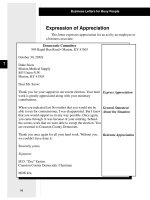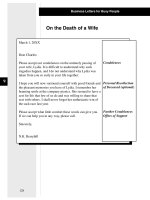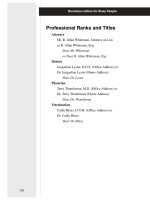JAPANESE FOR BUSY PEOPLE 9 docx
Bạn đang xem bản rút gọn của tài liệu. Xem và tải ngay bản đầy đủ của tài liệu tại đây (594.58 KB, 30 trang )
PZZ
Have you heard the term
sakura zensen?
The flower typifying spring in Japan is, undoubt-
edly,
sakura,
the cherry blossom. As spring approaches, people predict the day the cherry
(trees) will blossom and agree with friends on a day to go blossom viewing.
Japan
is an island country extenàing in a long (line) from south to north. Kyushu, Shikoku,
Honshu, Hokkaido-there's
quite a difference in temperatures, so the day the cherries blos-
som àiffers somewhat, too. In the southern part of Kyushu the cherries bloom around the end
of March, but in Hokkaido they bloom around the beginning of May. Thus, the cherry blossom
"front," a
line starting in the south of the Japanese archipelago and (moving) north, shows the
state of the cherry trees' blossoming. This takes as long as forty days.
In adàition to the cherry blossom front there are other flower fronts, such as the apricot
blossom front and the azalea front. Apricots start in Kyushu a whole lot earlier than the cherry
trees, but they reach Hokkaido at almost the same time (as the cherries). Therefore, if (you)
travel to Hokkaido in early or mid May, (you) can see (various) spring flowers at the same
time. On the other hand, when it gets to be auturnn the autumn leaves front makes its way
from north to south, dyeing the trees in the mountains
crirnson or yellow.
With flower viewing in the spring, maple
(leaf) excursions in the autumn and so on, people
enjoy each season (in turn).
9
Vocabulary
cherry blossom front
front
word
typify, represent
representation
undoubtedly
people
approach
predict
prediction, estimate
(cherry) blossom viewing
well, incidentally
extend, stretch, postpone
island country
Shikoku
(place name)
Honshu (place name)
quite
(air) temperature
difference
differ, be different
IlovpX,
L
L
i
QLvph
Gai
-71'4
-1;
southern part
end
beginning, first
thus, in this way
way, manner
about
archipelago
be (in the process of
)
blooming
state, circumstance, appearance
line
show, express
in addition to
apricot, Japanese
plum
azalea
such as
and so forth
a whole lot,
al1 the tirnelway
almost
therefore
(same as
f:d'
b)
first third of the month
second third of the month
d'l?
7
from
. .
.
to
.
.
.
auturnn
(lit.
"red") leaves
trees
red
yellow
dye
be advancing
maple leaf excursion
maple
excursion,
hunting
season
enjoy
dP?
2
2
6
VOCABULARY
Supplemental vocabulary
4~Lta
LO?
a
species of cherry
MXH
r)i,d'O
day of
blooming
i\?li+;iT
a species
of
maple
ZiLiv:
day the leaves turn
I.
&a#&,
z
i
L
i
q#&
5
i
h+!Liih iihrih
These
i%,@
are analogous to warm and cold weather fronts, so perhaps it is not surpris-
+?Lei
ing that information on their progress comes from the
3
L
L
i
S
L
i
,
the Meteoro-
logica1 Agency. Arnong its weather-related functions are predicting the harvest time of
fruits, but predictions and reports on the
$i
and
Z
i
L
i
are the most eagerly awaited.
*<h
The harbinger for the many varieties of cherry blossoms is the species known as
-T-
id>
\\L LD,andformaplesitis
\\/;li
$\%T'.
2.
$2
?<h
i
L
L
0
only blooms for a very short period, from five to ten days. If it rains or is
windy, which
is
typical spring weather
in
Japan, the blossoms may al1 fa11 overnight.
3.mY
5-376
'i
h
More literally this means "No matter what anyone says
.
.
."
The particle
'L
here emphasizes the number of days the cherry blossom front takes as
it moves from the south to the north of Japan. This use of
'L
reflects the speaker's
feelings of "so many" or "so much."
5.
11
V
-*
\
7
T
\
<
o
(llit.)
"The flowers bloom progressively."
Iitd
Adding
i
<
,
which means "to go," to the
7
form of verbs indicates the continuous
progress of the action.
ex.
1
i
108
"i;
Y
tLTi13
3Bo
,,89
*t*
"Swallows fly
(lit.
"go flying") south in October."
6 &I:
%O
xdT
Chd'L607'$o
i'&
C
li
ZI
li
'a
D
TB
is
equivalent to
L
TB
but less colloquial. (See p.
117.)
NOTES
227
-
-A
7.
*k
-i
-i
The kanji
h
indicates the repetition of the syllable(s) coming immediately before it,
sometimes with a phonetic change. Nouns in Japanese are generally written and
pro-
nounced the same whether singular or plural (as noted in Characteristics of Japanese
Grammar in Book I), but this is one way of specifying plurality. Other examples:
E
h.
l1
'4
li'&
"flowers";
E!
h
,
"countries";
&h,
"islands";
LL
h,
"mountains";
+k
h
,
"we." (See Book 111,
(
f:
<
':
LJ
L*
?'Z
?'it
htt
hil
Lesson
1.)
Words made plural with suffixes are comparatively few and must be learned as they are
encountered.
;k>
+d~
7':
27,
for example, is one way of pluralizing "you." From familiar to
d
t:
formal, there are a number of words for "we," such as
If
<
i;,
$h
7':
S
(the most com-
mon) and
$h
'f'
t
(humble/formal).
hi:(oL
hi:
L
8.
SI:
ia
,
i
a
t
A
L
+<i)
i1
6
11'.
i
h
l
When things are listed or enumerated, it is sometimes permissible to omit predicates
and, in fact, this
can create a dramatic effect.
I
Read this lesson's opening passage and answer the following questions.
QUIZ
OEZ
APPENDICES
~p
A:
Plain Forms and Connective Patterns
The plain adjective and verb forms given in the charts below are used in a nurnber of patterns. Excep
tions, which occur only in the case of a
Q
adjective or a noun followed by
f:,
are shown in boxes.
Verbs
Present
aff.
Reg. I1
\\4
i
\Q\
\t:
Irr.
;R4
l
*Q\
\
*
f:
l
-
Adjectives, Noun
+
T
f
I I
Present
I
Past
I
Four connective patterns using the following words and phrases are encountered
in
Book
11.
1.
Basic Pattern
Before
L
,
L
%
?
,
L
(
,
etc., verbs and adjectives end in the plain form without exception.
2.
Noun-modifying Pattern
Nouns (Lesson
71,
L
3
,
la
h
i
(Lesson 121,
9
t
'I
(Lesson
18).
When these words are modified, the following exceptions occur:
After
Q
adj.:
%d,
L
j
i?
/
L
<
,
etc.
After
noun:
Z
L"
t
0
$/
L
3,
etc.
li
A.
3.
T
L
a
i
Pattern
7
L
I
i
(Lesson
81,
f:
6
i
(Lesson 131,
d'
t
L
)2
ib
\
(Lesson 13)
6'
adjectives and nouns plus
fi
are exceptions. The stem of
Q
adjectives and nouns comes directly
before these words.
ib
adj.:
ed'
T
L
I
i
(after the stem)
noun:
L"
t
T
L
a
i
APPENDICES
23
1
n
4.
Q
0
7"
Pattern
01
T-b
(Lesson 11).
0
7"
(Lesson 13).
Q
adjectives and nouns plus
f:
are exceptions.
Q
adj.:
07"
Index:
la
;b>
i
\
(2),
f:
4
i
(31,
7"
L
h
i
(31,
1)'
'L
L
k1.
3
-e
L
(31,
0
7"
(41,
01
7-b
(41, noun (21,
Y
i
\
i
/M
<
i,$
i
i-,
f:
2
4
(11,
Y
? (21,
3
'L
1)
(2).
Notes: The number in the parentheses refer to the pattern number.
For other words and phrases,
such as
?A'
1)'
6,
Q
<
7
'L
i \i
\,
Z
Y
1)'h
b,
which follow other
forms, refer to their connective pattern in the
grarnrnar sections of the respective lessons.
B:
Grammatica1 Patterns and Common Constructions
'Crh
232
APPENDICES
&t4
A
7%
,.V
4
<q
?n
E
'I@+
Lf1$
TIY
%N$
-
'L-
8C
YlYY
C
l
T+FI
"14
7
p
1
31%
'Lf
1I$$
3%
CD2r
-
'.L/l-
LS
p1
=ossa7
Lesson
l7
68
Plain Style
69 -r.
-a
L~I
ma:
xar.
z:g;3:
72~7
?
V
lfi,
TL
h
t\&
Lfzo
Lesson
19
74
Potential
Lesson
20
78
-7
\
3
a
f
i9jf,\&
jL-
x;3'
?t\Tt\C
*
**
*
?
t:
li
+r
3
$0
C:
Verb
Conjugations
Except for the two irregular verbs
{
?
and
6,
al1 verbs belong to either the Regular
I
or Regular
I1
category and conjugate as in the foilowing tables. The
7
lfz
form comes from the
&
form, but
euphonic changes
occur
in
the case of most Regular
I
verbs. Note the last sound of the
&
stem is
underlined.
APPENDICES
-
-
d
I1
JeImax
C
\
1
S!
)
\
1
JO
~JOJ
1
aqL .uo!lda2xa auo JaquIauIax :aloN
71
Y'P
CPCf
(D
L-
1% Q
"4$!11\14
.L\jQ
L>I~{
TI$
(DYE
04 ~\14\~~
z>Y
TI/:L~X
irjrita
*lYl
1
(D?
'2
"t)
G.?4
>
Z
(1
ce
zxl+g
'1
l
(D:
'1
A
:I
':t
'.,p
':l'P
>p
':l
'(D
'2.E
(D
'?\4'Z
3
'2
(D
I1
"k~~ib
:)(l2 31(~723
(D)
uossaq
T
uossaq
s
uossay
p
uossay
E
uossay
:Q
'6
1
4
8
1 '1
'L
'I
'CD
'9
3 '3
'C
s4
'CD
'CD
'P
l
'a4 '>4
'I
l
z
3
CD
l
T
I1
ZI
uossay
(D
s
(D
'3
'P >P
'(D
'I
(D
',P
'Z
\P
'>4
'1
I1
h
i
-'<
->
greeting, address, 39
h
d
'/
3%
crimson, scarlet, 226
h
d'
6
i
bright, 21, 56
h
fi
4
dj
6
give up, be resigned, 208
<
be vacant, be empty,
(bel open,
l28
hit"6.
+If6
raise,79
h
L
;/W
leg, foot, 68
A
%
4'
6
//%d'
6
take care of, keep, 141
h
%
lf
6
,'%
1-f
6
deposit, entrust, 167
-la'/-ltdtlf
if,178
$5
ji
.;C
play, 33
h
t: t:
d'
i
\
warm, 56
t:
2
d'i
t
i
bright, clever, 21
->
bJ
6
gather, collect, assemble, 159
h
Y
/'?&
rest, 63
h
Y
T/'?&T
later, afterward, 99
7
t
3
2
A
announcement, 153
ho&
er, 28
T/
T-
b
apartment, 56
U"
6
bathe, 34
$5
.i:
'A'
i
dangerous, 120
h
2
')
not very, 198
$5
dj
/
'I%
rain, 89
h
4
Oh! (women's speech), 99
h
4
i
/#t
i
wash, 34
h
4
h
%
/&
%
show, express, 226
hk
L
k/g1~~eaceofmind;
L
A-6
6,
'$(C
%
6
be relieveci1 relaxed, 39
h
kt!
A/*S
safe, 120
h
i
guidante;
h
k
Q
i
\%
6
show
around, 28
i
'
2
,/
&
house, home, 86
i
3
/%T
C
going, 7
-i
3
/%T
bound for, 93
i
<
->
how old (for a person), 58
i
'If
If
Q/YlfZ
flower arranging, 34
(-7li) \\If'si~mustnot99
\
L"
d.
more than, 86
i
4
<"
/'
,%
<"
hurry, 33
i
'
t: ti
5
%
(phrase used before eating), 133
i
7':
ti
<
accept, receive (politer than
6
4
j
1,147
i\GIz
G;-R (in)aday,lO
ib6klkL
YP
j
-/-~~allyearround,28
i
6
ifk
/
-&
most, number one, 7
i
->
d\/'
-e
family, household, 191
L
d.
i
Ifkdji\ashardasonecan,59
i
->
7
2
i
\
'I
2
%
good-bye, 99
'
->
T
6
any-/sometime, 135
i
->
7
4
->
L
r
i
good-bye, 99
i
'
->
/a"\
full, 146
i
->
6
always, 153
i
\
,,'
dog, 171
i
2
0
i
6
l-/+n
i
6
1-
right away, before
it's too late, 62
i
/
meaning, 214
(Q)
horrible, nasty, unwelcome, 198
i
'
4
i
request, commission, 178
i
4
->
L
r
6
(polite form of
<
6
./'&
6,
i
<
,/'%T
<
,
i
i
61,167
6
need. 104
0dt6/XdtB
putin,184
i
6
/
fd
color, 62
t
'
6
li
4.2
7
a species of maple, 227
i
-'<
7
printing, 192
4
;/
A
b
7
5"
5'
-
instructor, 28
3
i
A
3.
-
whiskey, 57
'?
-
IL
wool, 16
i
+,,)C
j
vi
sit,
.
ask (polite), 178
i
l
f
6
,.'%i?
6
take (an examination), receive,
undergo,
have, 99
i
Z'
3
2
h
6
,.,
fi
EJ
6
move around, 153
?
Z'
<
//%
<
run, move, operate, 89
i
L
6/
?&6
back, 15
i
t:
song;
?
t:
?
sing, 33
?
6
C
L,,'
h
deposit, partial payrnent, 128
6
D
our, 49
i
G
YP
j
universe;
i
6
YP
i
V
Z
i
L
astronaut, 56
7
<
L
i
beautiful, 192
JAPANESE-ENGLISH GLOSSARY
2
horse, 16
i
2
)2
6
/
Y
2
)2
6
be born, 121
dh
apricot, Japanese plurn, 226
i
6
back, reverse (side);
6
<'
6
'
6
D
back entrance, 178
i
's
)2
/
3
')
3
)2
sold out, 86
)2
L
delighted, happy, 141
i
7
driving;
7
f
4
drive, 33
i
Y"
i
exercise;
i
Y'
i
f
4
exercise, 171
2
Oh dear (excalamation of surprise), 141
2
\d'L
h/%??$%
spoken English, 121
2 2
Y
let me see, 160
2
3
L
\
L
/',%
E
station employee, 15
2
Y"
L
\/
%F
Edo period,
111
2
6
\
important, illustrious, eminent, 154
2
6
.i:
choose, 80
z
L
?
i
performance, recitai:
X
X,
?
i
f
4
perform, l92
2
pencil, 104
2
1
reserve, restraint,
diffidente;
2
L
1
?i
<
without hesitationlreserve, 147
k;
L
<
7
how old (for a person), 58
k; k;
L
\/
9
L
many, much, 86
k;
k;+k
\
hordesllots of people, 86
f
-
k
/
'
4
motorcycle, 219
f
-
f'
-
OB (old boy), alumnus/i, 153
k; k;
A
?
-h\
last day of year, 191
k;
-h\
6
5 2
k;
5
2
(someone eise's)
mother (polite), 121
k;
-h\
2
Q 5
\
welcome home, 105
k;-h,lf"'c 2
7"Thankyou,68
k;
-h,
L
L
strange, funny, 203
k;
's
V
<
5
client, guest, visitor, 91
k;
2
4
3
4
get up, wake up, 21; happen,
occur, 146
k;
<
put, set up,
44
;h'
{
5 2
(someone else's) wife (polite),
111
k;
<
'I
6
m/%
<
gift, 141
k;
<
6
send (a present), 203
k;
<
4
/%
4
take, seelsend off, escort, 185
k;
<
)2
4
be late, 104
k;
z
5
L
,/
k;
'-f
5
X,
(someone else's)
child (ren), 58
k;5 3ICL7)2L\L af/k;#l:L7)2\\
L 2
f
good-bye, 63
k;
L
.t.
K
i)
f
4
chat, 79
k;
L
1
i
-h'~/k;X8
NewYear's,198
k;
f
push, 184
k;
f
's
?i
6
07,
'
k;*
3 Q%?J
thing(s) you like, 28
k;+khI:?ia ';f;w%l:Q4
beunderthe
care of, be indebted to, 141
k;
?
i
L
3
funeral, l34
k;
?
)2
i
2
f
excuse me, be sorry (polite), 128
k;
f:
i
\
L
1:
/
%h$ I
:
Take care of yourself, 63
k;
%
4
drop, fall, 22; fail, 159
k;
7
Y
husband, 184
k;
Y
sound, 184
k;
Y
f
lose, drop, 22
k;
Y
Y'lf/k;%if
delivery,203
k;
Y
Y"1f
5 3 /%%l?
#
consigee,
destination, 203
k;
Y Y
L
year before last, 116
k;
Y
?i
,/
h
h
adult, 93
k;
Y"
5
<
be surprised, 159
%?i
I'/m
L
same, 141
k;
l
i
+A'
/
k;
z
E
(cherry) blossom viewing, 225
k;
2
Y
i
box lunch, 34
k;
13
2
4
remember, memorize, 207
k;
1
3k
/
k;
O-Bon (midsumrner festival), 86
k;
A
I?'
souvenir, 133
k;
dh
T
Y
i
5'
2<'L
\
2
f
congratulations, 203
k;
6
i
\/L
heavy, 79
k;
6
i
/,%i
think, 86
k;
6
7
/&
front, face, surface, 178
k;
a
<'
swim, 28
k;
6
f
withdraw, 104
k;
f
L
\
warm water;
k;
f
L
7'-
)L
heated
(swimming) pool, 28
-h,
or (particle), 63
d,,/i)C
Tuesday, 34
h\/%
lesson (counter), 79
-h'/%
section, 49
fi
-
F
credit card, 99; greeting card, 141
fl'-
)L
7
1/
F
girifriend, 141
-
-h
h
side, 178
-h\
/m
time(s) (counter), 34
-h\\
L
k/&E
club/society member, 167
-h\
L
-h\
U;'/
Eì
day of bloorning, 227
-h'\
\
Z
<
Z"/
Yb
a
2
foreign language, 219
rr"
248
JAPANESE-ENGLISH GLOSSARY



![japanese for busy people 2 [kana version]](https://media.store123doc.com/images/document/14/rc/my/medium_mye1395897198.jpg)





